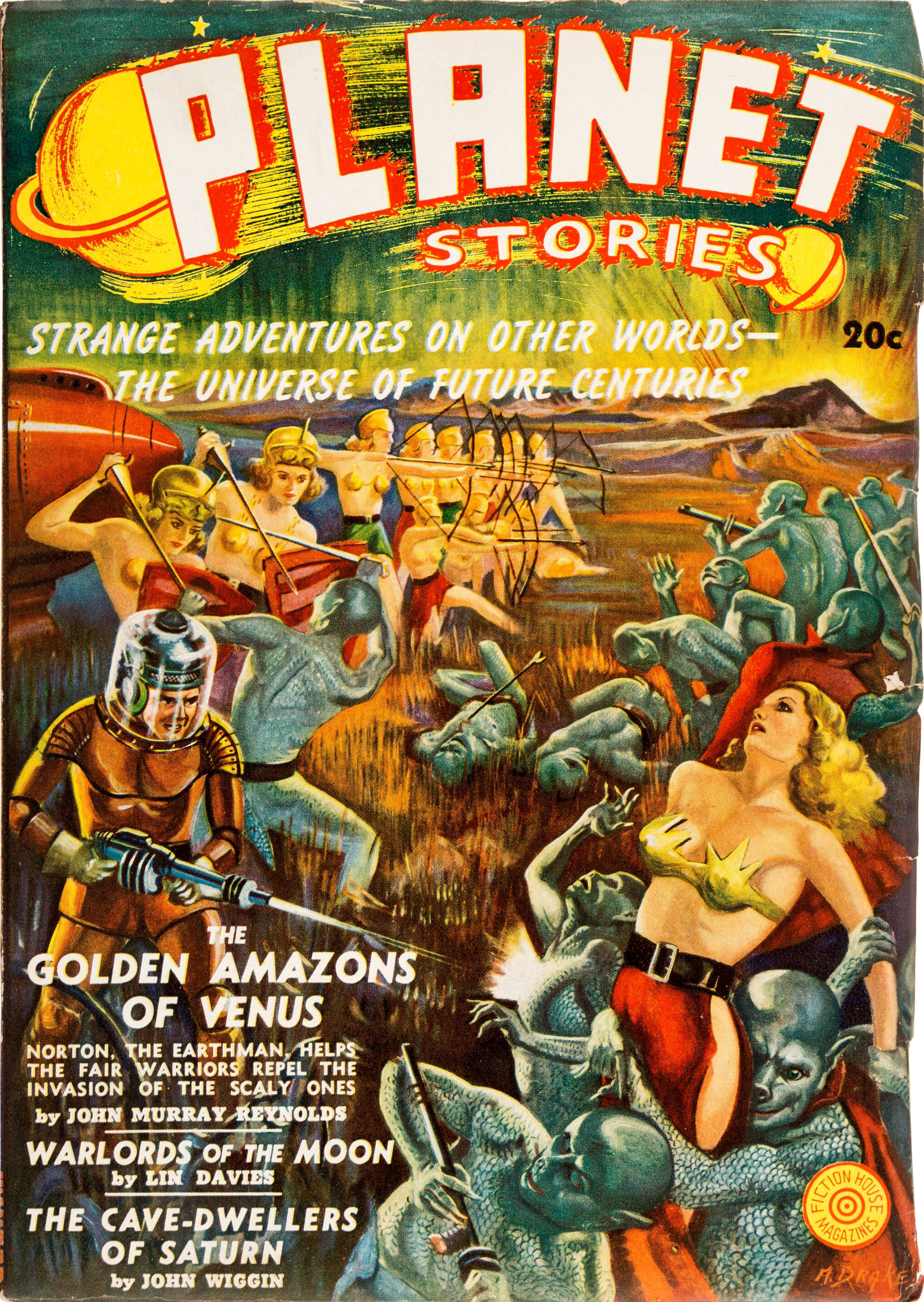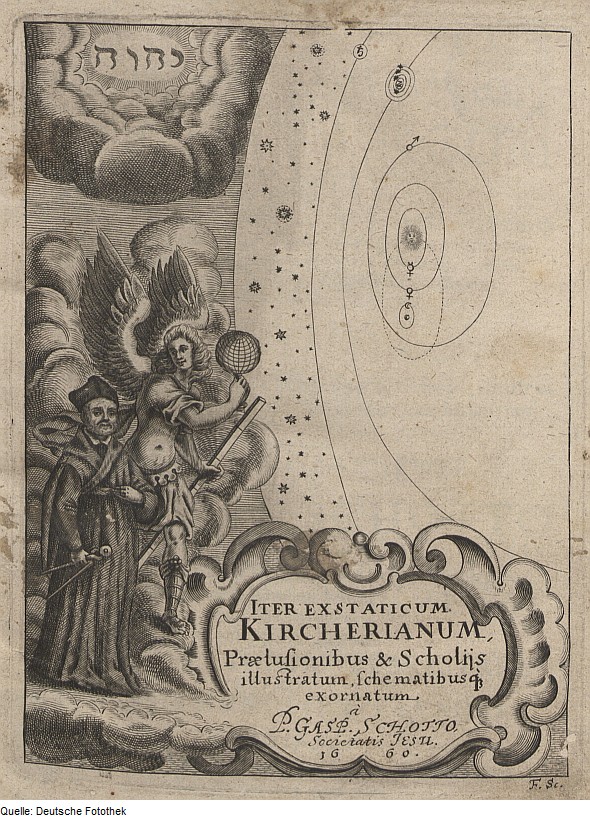|
Venus In Fiction
The planet Venus has been used as a setting in fiction since before the 19th century. Its impenetrable cloud cover gave science fiction writers free rein to speculate on conditions at its surface; the planet was often depicted as warmer than Earth but still habitable by humans. Depictions of Venus as a lush, verdant paradise, an oceanic planet, or fetid swampland, often inhabited by dinosaur-like beasts or other monsters, became common in early pulp science fiction, particularly between the 1930s and 1950s. Some other stories portrayed it as a desert, or invented more exotic settings. The absence of a common vision resulted in Venus not developing a coherent fictional mythology, in contrast to the image of Mars in fiction. When portrayed, the native sentient inhabitants, Venusians, were generally portrayed as gentle, ethereal and beautiful. Early science fiction writers who set their stories on Venus included Otis Adelbert Kline in the 1920s; Edgar Rice Burroughs, Olaf Stapledo ... [...More Info...] [...Related Items...] OR: [Wikipedia] [Google] [Baidu] |
Frederik Pohl
Frederik George Pohl Jr. (; November 26, 1919 – September 2, 2013) was an American science-fiction writer, editor, and fan, with a career spanning nearly 75 years—from his first published work, the 1937 poem "Elegy to a Dead Satellite: Luna", to the 2011 novel ''All the Lives He Led''. From about 1959 until 1969, Pohl edited ''Galaxy'' and its sister magazine '' If''; the latter won three successive annual Hugo Awards as the year's best professional magazine. His 1977 novel '' Gateway'' won four "year's best novel" awards: the Hugo voted by convention participants, the Locus voted by magazine subscribers, the Nebula voted by American science-fiction writers, and the juried academic John W. Campbell Memorial Award. He won the Campbell Memorial Award again for the 1984 collection of novellas ''The Years of the City'', one of two repeat winners during the first 40 years. For his 1979 novel ''Jem'', Pohl won a U.S. National Book Award in the one-year category Science Fi ... [...More Info...] [...Related Items...] OR: [Wikipedia] [Google] [Baidu] |
Emanuel Swedenborg
Emanuel Swedenborg (, ; born Emanuel Swedberg; 29 March 1772) was a Swedish pluralistic-Christian theologian, scientist, philosopher and mystic. He became best known for his book on the afterlife, ''Heaven and Hell'' (1758). Swedenborg had a prolific career as an inventor and scientist. In 1741, at 53, he entered into a spiritual phase in which he began to experience dreams and visions, notably on Easter Weekend, on 6 April 1744. His experiences culminated in a "spiritual awakening" in which he received a revelation that Jesus Christ had appointed him to write ''The Heavenly Doctrine'' to reform Christianity. According to ''The Heavenly Doctrine'', the Lord had opened Swedenborg's spiritual eyes so that from then on, he could freely visit heaven and hell to converse with angels, demons and other spirits, and that the Last Judgment had already occurred in 1757, the year before the 1758 publication of ''De Nova Hierosolyma et ejus doctrina coelesti'' (English: ''Concerning the ... [...More Info...] [...Related Items...] OR: [Wikipedia] [Google] [Baidu] |
Itinerarium Exstaticum
''Itinerarium exstaticum quo mundi opificium'' is a 1656 work by the Jesuit scholar Athanasius Kircher. It is an imaginary dialogue in which an angel named Cosmiel takes the narrator, Theodidactus ('taught by God') on a journey through the planets. It is the only work by Kircher devoted entirely to astronomy, and one of only two pieces of imaginative fiction by him. A revised and expanded second edition, entitled ''Iter Exstaticum'', was published in 1660. Background In his 1641 work '' Magnes sive de Arte Magnetica'', Kircher had argued against the cosmological theories of both Kepler and Galileo, but had written nothing on the subject since. It is not clear why Kircher took it up again, though the preface mentions encouragement from Emperor Frederick III. The book was dedicated to Queen Christina of Sweden who visited the Vatican just after it was published. Narrative ''Itinerarium Exstaticum'' relates how, lulled into a sleepy reverie by a concert of sacred music in the Jesuit ... [...More Info...] [...Related Items...] OR: [Wikipedia] [Google] [Baidu] |
Athanasius Kircher
Athanasius Kircher (2 May 1602 – 27 November 1680) was a German Jesuit scholar and polymath who published around 40 major works, most notably in the fields of comparative religion, geology, and medicine. Kircher has been compared to fellow Jesuit Roger Joseph Boscovich and to Leonardo da Vinci for his enormous range of interests, and has been honoured with the title "Master of a Hundred Arts".Woods, p. 108. He taught for more than 40 years at the Roman College, where he set up a wunderkammer. A resurgence of interest in Kircher has occurred within the scholarly community in recent decades. Kircher claimed to have deciphered the hieroglyphic writing of the ancient Egyptian language, but most of his assumptions and translations in this field were later found to be incorrect. He did, however, correctly establish the link between the ancient Egyptian and the Coptic languages, and some commentators regard him as the founder of Egyptology. Kircher was also fascinated ... [...More Info...] [...Related Items...] OR: [Wikipedia] [Google] [Baidu] |
Solar System
The Solar System Capitalization of the name varies. The International Astronomical Union, the authoritative body regarding astronomical nomenclature, specifies capitalizing the names of all individual astronomical objects but uses mixed "Solar System" and "solar system" structures in theinaming guidelines document. The name is commonly rendered in lower case ('solar system'), as, for example, in the ''Oxford English Dictionary'' an''Merriam-Webster's 11th Collegiate Dictionary''. is the gravitationally bound system of the Sun and the objects that orbit it. It formed 4.6 billion years ago from the gravitational collapse of a giant interstellar molecular cloud. The vast majority (99.86%) of the system's mass is in the Sun, with most of the remaining mass contained in the planet Jupiter. The four inner system planets— Mercury, Venus, Earth and Mars—are terrestrial planets, being composed primarily of rock and metal. The four giant planets of the outer system are ... [...More Info...] [...Related Items...] OR: [Wikipedia] [Google] [Baidu] |
Voyage à Venus
Voyage(s) or The Voyage may refer to: Literature *''Voyage : A Novel of 1896'', Sterling Hayden * ''Voyage'' (novel), a 1996 science fiction novel by Stephen Baxter *''The Voyage'', Murray Bail * "The Voyage" (short story), a 1921 story by Katherine Mansfield * "Voyage", a poem by Patti Smith from her 1996 book '' The Coral Sea'' * ''Voyages'' (poem), a 1926 poem by Hart Crane *Le Voyage, 1996 graphic novel, see Edmond Baudoin *Le Voyage, poem by Baudelaire Film and television * ''The Voyage'' (1921 film), an Italian silent drama film * ''The Voyage'' (1974 film), an Italian film * ''Voyage'' (2013 film), a Hong Kong film made mostly in English * ''Voyages'' (film), a 1999 film directed by Emmanuel Finkiel * ''Voyage'' (1993 film), a 1993 American TV film directed by John Mackenzie * Voyage.tv, an American online travel channel * Voyages Television, an international travel marketing channel * Voyage (French TV channel), a television channel in France operated by Path ... [...More Info...] [...Related Items...] OR: [Wikipedia] [Google] [Baidu] |
Achille Eyraud
Achille is a French and Italian masculine given name, derived from the Greek mythological hero Achilles. It may refer to: People Artists * Achille Beltrame (1871–1945), Italian painter * Achille Calici (c. 1565–?), Italian painter * Achille Castiglioni (1918–2002), Italian designer * Achille Cattaneo (1872–1931), Italian painter * Achille Devéria (1800–1857), French painter and lithographer * Achille Duchêne (1866–1947), French garden designer * Achille Empéraire (1829–1898), French painter * Achille Formis (1832–1906), Italian painter * Achille Funi (1890–1972), Italian painter * Achille Glisenti (1848–1906), Italian painter * Achille Granchi-Taylor (1857–1921), French painter and illustrator * Achille Leonardi (c. 1800–1870), Italian painter * Achille Locatelli (painter) (1864–1948), Italian painter * Achille Mauzan ((1883–1952), French illustrator, painter and sculptor * Achille Etna Michallon (1796–1822), French painter * Achille Molli ... [...More Info...] [...Related Items...] OR: [Wikipedia] [Google] [Baidu] |
Pamela Sargent
Pamela Sargent (born March 20, 1948) is an American feminist, science fiction author, and editor. She has an MA in classical philosophy and has won a Nebula Award. Sargent wrote a trilogy concerning the terraforming of Venus that is sometimes compared to Kim Stanley Robinson's Mars trilogy, but predates it. She also edited various anthologies to celebrate the contributions of women in the history of science fiction including the ''Women of Wonder'' series. She also edited the '' Nebula Award Showcase'' from 1995 to 1997. She is noted for writing alternate history stories. She also collaborated with George Zebrowski on four ''Star Trek'' novels. Personal life Pamela Sargent was born in Ithaca, New York, and raised as an atheist. She attended the State University of New York at Binghamton, attaining a master's degree in philosophy. She currently lives in Albany, New York. Bibliography Seed Trilogy #''Earthseed'' (1983) #'' Farseed'' (2007) #''Seed Seeker'' (2010) Venus #'' ... [...More Info...] [...Related Items...] OR: [Wikipedia] [Google] [Baidu] |
Ben Bova
Benjamin William Bova (November 8, 1932November 29, 2020) was an American writer and editor. During a writing career of 60 years, he was the author of more than 120 works of science fact and fiction, an editor of ''Analog Science Fiction and Fact'', for which he won a Hugo Award six times, and an editorial director of '' Omni''; he was also president of both the National Space Society and the Science Fiction Writers of America. Personal life and education Ben Bova was born on November 8, 1932, in Philadelphia. He graduated from South Philadelphia High School in 1949. In 1953, while attending Temple University in Philadelphia, he married Rosa Cucinotta; they had a son and a daughter. The couple divorced in 1974. That year he married Barbara Berson Rose. Barbara Bova died on September 23, 2009. Bova dedicated his 2011 novel ''Power Play'' to Barbara. In March 2013, he announced on his website that he had remarried, to Rashida Loya. Bova was an atheist and was critical of what he ... [...More Info...] [...Related Items...] OR: [Wikipedia] [Google] [Baidu] |
Retro Style
Retro style is imitative or consciously derivative of lifestyles, trends, or art forms from history, including in music, modes, fashions, or attitudes. In popular culture, the "nostalgia cycle" is typically for the two decades that begin 20–30 years ago. Definition The term ''retro'' has been in use since 1972 to describe on the one hand, new artifacts that self-consciously refer to particular modes, motifs, techniques, and materials of the past. But on the other hand, many people use the term to categorize styles that have been created in the past. Retro style refers to new things that display characteristics of the past. Unlike the historicism of the Romantic generations, it is mostly the recent past that retro seeks to recapitulate, focusing on the products, fashions, and artistic styles produced since the Industrial Revolution, the successive styles of Modernity. The English word ''retro'' derives from the Latin prefix ''retro'', meaning backwards, or in past times. In Fra ... [...More Info...] [...Related Items...] OR: [Wikipedia] [Google] [Baidu] |
Terraforming Of Venus
The terraforming of Venus or the terraformation of Venus is the hypothetical process of engineering the global environment of the planet Venus in such a way as to make it suitable for human habitation. Terraforming Venus was first proposed in a scholarly context by the astronomer Carl Sagan in 1961, although fictional treatments, such as ''The Big Rain'' of The Psychotechnic League by novelist Poul Anderson, preceded it. Adjustments to the existing environment of Venus to support human life would require at least three major changes to the planet's atmosphere: # Reducing Venus's surface temperature of # Eliminating most of the planet's dense carbon dioxide and sulfur dioxide atmosphere via removal or conversion to some other form # The addition of breathable oxygen to the atmosphere. These three changes are closely interrelated because Venus's extreme temperature is due to the high pressure of its dense atmosphere and the greenhouse effect. History Prior to the early 1960s, ... [...More Info...] [...Related Items...] OR: [Wikipedia] [Google] [Baidu] |








